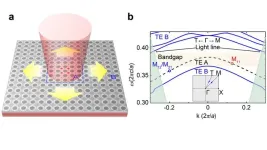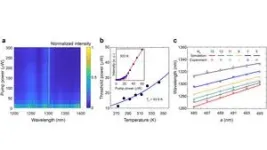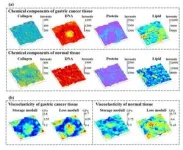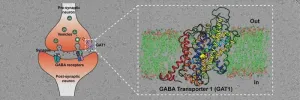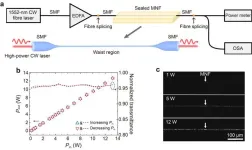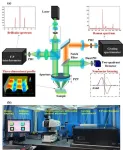Ultra-low threshold continuous-wave quantum dot mini-BIC lasers
2023-07-07
(Press-News.org)
Lasers with ultra-low threshold and compact size are highly desirable in photonic integrated circuits, aiming at the application of optical communications, chip-scale solid-state LIDAR and quantum information. The general approach to realizing such lasers is to effectively trap light and boost light-matter interaction by embedding gain materials into few- or sub-wavelength scale optical cavities with high quality (Q) factor and/or small mode volume (V-mode).
Low-threshold lasing has been realized on planar photonic crystal via introducing defect-type PhC modes or photonic bound states in the continuum (BICs) modes. For lasing action, the reported defect-type PhC lasers, while exhibiting extremely small V-mode and therefore ultra-low threshold, nevertheless suffers instability caused by sensitivity to the structural disorder. In this regard, BIC lasers that may benefit from topological robustness are one of the most promising alternative architectures. However, radiative BIC (quasi-BIC) modes in PhC slabs or gratings with high Q-factor are often realized requiring extended lateral periodic structures to reduce in-plane light leakage, therefore intrinsically limiting their footprint to hundreds of unit-cells. In addition, BICs can only confine light in vertical direction, making its threshold difficult to further reduce.
The research group of Ying Yu and Siyuan Yu from Sun Yat-sen University presents the realization of CW operated BIC lasers with low-thresholds and small V-modes by combining O-band InAs/GaAs epitaxial QD gain material with mini-BIC cavities. Benefitting from the three-dimensional confinement of both light and carriers provided by the mini-BIC cavity and the QD, the ultra-low threshold of below 20 μW and small size of ~2.5×2.5 μm2 are achieved.
Different from the traditional BIC, mini-BIC not only confines light in the vertical direction, but also traps light in the transverse direction by the photonic bandgap of the lateral hetero-structure. Therefore, it has no requirement for long-range periodicity and thus allows for smaller structural size. Mini-BIC structure consists of two sets of photonic crystals with different periods, A and B, as shown in Fig. 1a. Cavity A serves as a resonant microcavity for lasers. Since it is a finite photonic crystal, its mode exists as discrete state Mpq in k-space (where p and q are positive integers, such as M11). By designing the state Mpq of A to be exactly in the bandgap of B, light can be laterally trapped. As shown in Fig. 1b, M11 and M12/M21 are resonant states in the continuum above the light cone. To further enhancing vertical light confinement, the discrete state could be designed to converge with accidental BIC modes in k-space, by fine-tuning the lattice constant of region A and the hole radius. The Q factor of preferred lasing mode could be also further improved.
Experimentally, the researchers first fabricate mini-BIC structure on InAs/GaAs QD active membrane with micromachining, and then transfer the active membrane to the glass substrate. Finally, the surface of membrane was covered with a layer of glass using an ultraviolet curing adhesive, to ensure the mirror-flip symmetry of PhC slab. By design, continuous-wave, single mode lasing is achieved with the cavity size down to 5×5 unit-cells (~2.5×2.5 μm2 with a mode volume of 1.16(λ/n)3). As shown in Fig. 2a, the device exhibits an ultra-low single mode lasing threshold of 17 μW (0.074 kW cm-2). Further temperature dependent laser performance test shows that the maximum operating temperature can reach 343 K (70 ℃), and the characteristic temperature is fitted as 93.9 K, as shown in Fig. 2b. By careful engineering of structural parameters, the mini-BIC lasers have also been tuned across a wavelength range of 80 nm (Fig. 2c).
In summary, the researchers demonstrate a structure that enabling effective trapping of both light and carriers in all three dimensions, by fabricating a miniaturized BIC cavity in an epitaxial QD gain membrane. They successfully achieve efficient, high spectral quality, precisely wavelength engineered miniature laser in the 1310 nm O-band wavelength range. The mini-BIC lasers, fabricated by membrane transfer technique, can be flexibly implemented on different substrate such as silicon or LiNbO3. With its advantages in terms of a small footprint, ultralow threshold and adaptability for integration, precisely wavelength engineering, the mini-BIC lasers offer a perspective light source for future PICs aimed at high-capacity optical communications, sensing and quantum information.
END
ELSE PRESS RELEASES FROM THIS DATE:
2023-07-07
Using Cryo-EM, a powerful microscopy technique, researchers at IISc and collaborators have decoded the molecular architecture of a transporter protein controlling the movement of a key neurotransmitter.
Neurons or nerve cells communicate by releasing chemical signals called neurotransmitters. Each neurotransmitter can activate specific sets of proteins called receptors that in turn either excite or inhibit neural communication. A balance between excitation and inhibition is vital for the neural circuitry to maintain normal structure and function. Imbalances in excitatory or inhibitory inputs can result in disorders like seizures, anxiety, and schizophrenia.
The inhibitory neurotransmitter ...
2023-07-07
Optical MNFs are cylindrical optical waveguides with diameter below or close to the wavelength of the light. Since its first experimental demonstration [Nature 426, 816 (2003)], low-loss silica MNF has been attracting increasing attention in wide applications from optical sensors, atom optics, nonlinear optics to optomechanics. Generally, increasing the waveguiding mode power is the most effective approach to enhance light-matter interaction, and explore new opportunities for both scientific research and technological applications. However, the highest CW mode power reported so far in a MNF is ~0.4 W [AIP Adv. 4, 067124 (2014)], with typical waveguiding ...
2023-07-07
There are obvious differences between cancerous cells and normal cells in morphology, chemical properties and mechanical properties. The detection of cytochemical and mechanical properties of tumor tissues can provide multi-dimensional information for the pathological process of cells and human tissues. Among the existing detection methods for the morphology, mechanics and chemical properties of tissue and cells, confocal Raman spectroscopy can detect the chemical properties of micro-regions of samples without contact and label, and confocal Brillouin spectroscopy can detect ...
2023-07-07
Regulations are urgently needed to protect children from harm in the unregulated online world, researchers at the University of Otago, New Zealand, say.
The call comes as the researchers publish the results of their study into the after-school habits of 12-year-olds. Their research, published today in the New Zealand Medical Journal, finds children are spending a third of their after-school time on screens, including more than half their time after 8pm.
Senior researcher Dr Moira Smith from the University's Department ...
2023-07-07
While there is extensive data on the high rates of HIV, STIs and unintended pregnancies among Black populations in the U.S., this racial category problematically subsumes the ethnic diversity of immigrant Black populations. Today, one in ten Black people in the U.S. are immigrants, with Caribbean immigrants accounting for approximately 46% of the total Black immigrant population.
It can’t be assumed that the variety of effective behavioral interventions (EBIs) that exist to address sexual and reproductive health for Black populations will be effective with Afro-Caribbean ...
2023-07-07
Sophia Antipolis, 7 July 2023: Unprocessed red meat and whole grains can be included or left out of a healthy diet, according to a study conducted in 80 countries across all inhabited continents and published today in European Heart Journal, a journal of the European Society of Cardiology (ESC).1 Diets emphasising fruit, vegetables, dairy (mainly whole-fat), nuts, legumes and fish were linked with a lower risk of cardiovascular disease (CVD) and premature death in all world regions. The addition ...
2023-07-07
HAMILTON, ON (July 6, 2023) – A study led by McMaster University and Hamilton Health Sciences researchers at the Population Research Health Institute (PHRI) has found that not eating enough of six key foods in combination is associated with a higher risk of cardiovascular disease (CVD) in adults.
Consuming fruits, vegetables, legumes, nuts, fish and whole-fat dairy products is key to lowering the risk of CVD, including heart attacks and strokes. The study also found that a healthy diet can be achieved in various ways, ...
2023-07-07
PORTLAND, Oregon -- A vaccine originally developed to prevent bacteria-caused diarrhea has now also been found to help infant nonhuman primates grow faster, according to a new study published in Nature Communications.
“The 160 million people worldwide who get sick every year from Campylobacter bacteria is far too many,” said the study’s lead researcher, Mark Slifka, Ph.D., a professor at Oregon Health & Science University’s Oregon National Primate Center. “We need a new tool to prevent bacterial diarrhea in babies and to enable more children to grow into healthy adults, and this vaccine approach looks ...
2023-07-07
Research conducted by The University of Queensland has revealed that Queensland native forestry, including timber harvesting, could actually help conserve biodiversity and mitigate climate risks.
Dr Tyron Venn from UQ’s School of Agriculture and Food Sustainability reviewed more than 350 publications, studying the ecological and economic impacts of Queensland native forest management, which includes everything from fire management to timber harvesting.
“Stopping forestry in Queensland’s native forests may sound like a positive outcome for the environment, but the research suggests that it would further shift our impacts offshore and increase ...
2023-07-07
A global study, led by UCL and UCLH and sponsored by Roche, has shown that the cancer immunotherapy atezolizumab1 significantly improved the overall survival of advanced stage non-small cell lung cancer patients who were not able to be treated with platinum-containing chemotherapy, when compared to single-agent chemotherapy.
The trial results, published today in The Lancet, are good news for non-small cell lung cancer patients who are not eligible for standard of care platinum-based chemotherapy, due to concerns about their ability to withstand ...
LAST 30 PRESS RELEASES:
[Press-News.org] Ultra-low threshold continuous-wave quantum dot mini-BIC lasers
